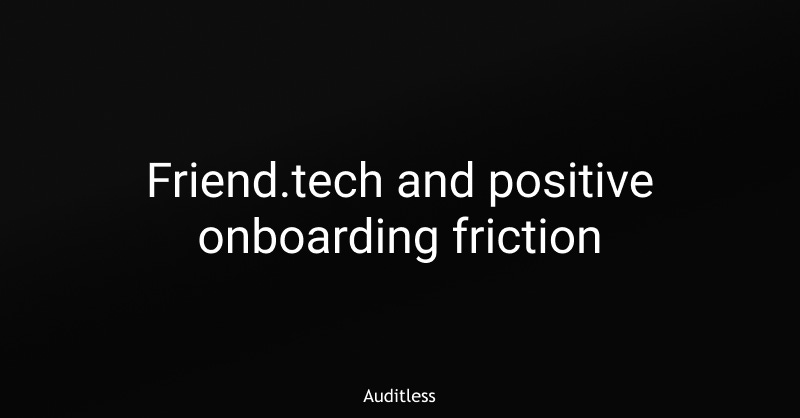friend.tech and positive onboarding friction
The case for PWAs, arcade wallets and other gadgets.
I tried out friend.tech.
Is the onboarding that good?
Surely, a web3 app that got so much traction in such a short period of time would have absolutely frictionless onboarding…
This is what I saw:
Turns out, the app is quite picky about what you need to do to join:
First, you need to visit friend.tech on a phone
Add the app to your home screen
Create an account using your email
Get an invite code (you can search from them using this search term on Twitter)
Connect Twitter
Bridge ETH to Base and your friends.tech wallet
Buy your first key to start issuing more
Is this just web3 being annoying?
We’ve all gone through some web3 onboarding processes which require us to install 3 patches to our hardware wallets, send 5 different signature/approve transactions and jump into the browser inspect window to fiddle with the JavaScript.
Sometimes web3 onboarding asks a lot of us.
But that's not what's happening here.
Friend.tech only introduces friction where it needs in order to distinguish you from a low-retention user.
Step 1. Maximize retention through onboarding
This is of course the traditional web2 social media onboarding model.
Ever heard about Facebook's 7 friends in 10 days rule?
It started when early Facebook growth team did a retention cohort analysis.
They discovered that users who added 7 friends in the first 10 days retained at a much higher rate than less engaged users.
When I interned at the Twitter growth team we had a similar idea about how many users should someone follow and how many tweets they would make before retention increases.
Can you guess what happened next?
Web 2 companies started to reverse-engineer the conditions for high-retention and mandating them at onboarding.
Ever been asked to follow or befriend a couple people before progressing in a social app?
It all follows the same playbook:
Define what additional actions a user needs to take to retain at a higher rate and mandate that they take those actions.
No spectators allowed.
Which brings us to the merits of PWAs – a technology used to implement friend.tech.
Step 2. Mandate use of PWAs
A Progressive Web App is a web app that follows certain standards which allows it to be treated like a native app in several important ways:
It can be installed on the home screen
It can run in the background and offline
It can issue notifications.
For the more technical among you, a PWA differs from a web app in two ways:
It has a manifest file which provides various metadata (such as name & app icon)
It registers a service worker, which is a script written in JavaScript that manages how your PWA interacts with network resources. In particular it can implement caching and help support an offline experience.
The benefit of PWAs is that developers can create a cross-platform native-like application using HTML, CSS and JavaScript.
However, they are very different from using a framework like React Native.
React Native also allows developers to use web technologies, but creates real native applications intended for app stores.
How PWAs contribute to retention hacking
One attractive feature of PWAs for crypto Founders is that they don't need to be hosted on the app store and therefore don't have to follow guidelines or share revenue with Apple.
But simple web apps also support crypto transactions without app store intermediation.
The real benefit is retention hacking. PWAs can exist on the home screen, encouraging more frequent access and they also get access to system notification.
From a security perspective, PWAs also don't rely on any browser's storage which may be attractive from a key storage perspective.
Step 3. Ask the user to send a transaction
Friend.tech also requires the bridging of funds and the creation of your first key.
When people join friend.tech, they want to browse around and see what is happening on the platform.
The app knows, however, that without funds or creating their own private group chat, the user will not be able to enjoy the platform and stay.
So they offer a trade – set up your account and we will satisfy your curiosity.
It worked for me.
Step 4. Remove friction everywhere else.
In other areas that aren't retention-sensitive, friend.tech removes friction.
Friend.tech creates a wallet for each user on their behalf.
It's a recent trend – Odin shared this screenshot of how Arcade accounts work in Loot Survivor.
In friend.tech, the wallet is created automatically but the user retains ownership by supporting the extraction of the seed phrase.
This does not seem like the most secure approach but likely offers the right tradeoff for most small budget speculators.
The modern onboarding playbook
So here's the conclusion:
Add friction where it improves retention (or lifetime value in the most general sense): mobile, home screen install, email & Twitter connection, minting the first key are in this category
Remove friction everywhere else: arcade wallets, simple 4-button UX, 1-click notifications fall in this category.
This creates the fastest possible path from a user wanting to try your app until their first meaningful transaction.





